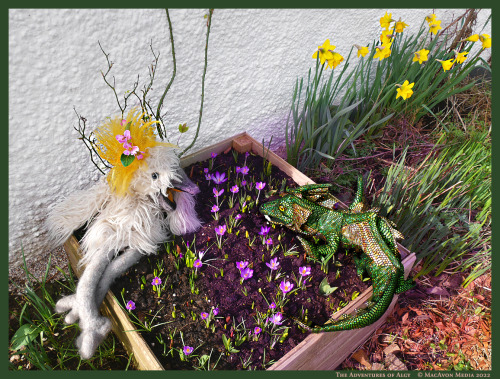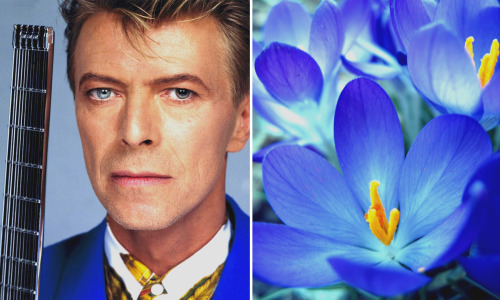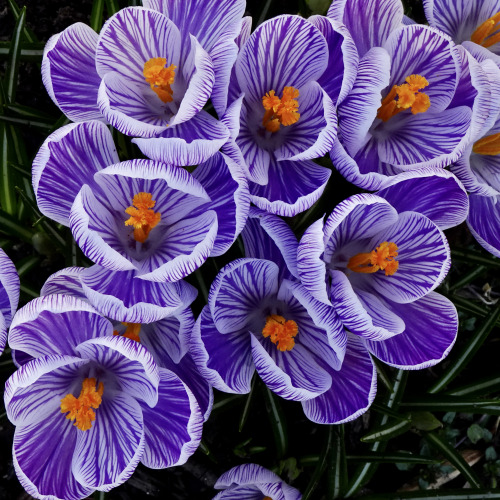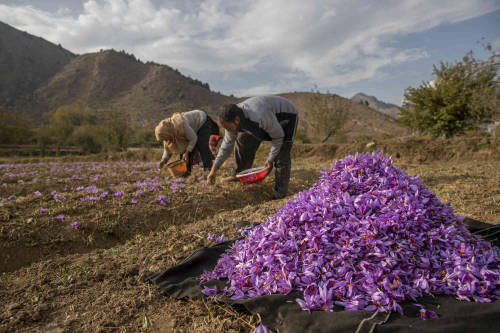#crocuses
Thrilled by its encounter with the first daffodils that it had ever seen, the little green dragon begged to see more flowers. In its arid and windswept homeland of faraway Patadragonia, the strange wee creature had rarely seen a flower, and certainly nothing as beautiful as the spring flowers of the temperate northern countries.
But it was only mid-March in the wild west Highlands of Scotland: there had evidently been plenty of snowdrops earlier on, but they had all finished flowering now, and most of the crocuses which normally grew in Algy’s assistant’s lawn had been flattened by the wind and the rain. Algy was temporarily at a loss, until his assistant pointed him at a wee raised box bed by her house wall, in which she had planted a new collection of spring bulbs the previous autumn. It was full of jewel-like crocuses which were only now beginning to turn their faces to the sun. The little green dragon was so enthralled by this new discovery that he began to glow in a purple hue.
Algy laughed, and recited an old poem to his funny little friend:
They heard the South wind sighing
A murmur of the rain;
And they knew that Earth was longing
To see them all again.While the snow-drops still were sleeping
Beneath the silent sod;
They felt their new life pulsing
Within the dark, cold clod.Not a daffodil nor daisy
Had dared to raise its head;
Not a fairhaired dandelion
Peeped timid from its bed;Though a tremor of the winter
Did shivering through them run;
Yet they lifted up their foreheads
To greet the vernal sun.And the sunbeams gave them welcome,
As did the morning air—
And scattered o’er their simple robes
Rich tints of beauty rare.Soon a host of lovely flowers
From vales and woodland burst;
But in all that fair procession
The crocuses were first.
[Algy is quoting most of the poem The Crocuses by the 19th century American poet Frances Ellen Watkins Harper.]
Post link






Spring flowers in the park :)




1/3/22
Spring is on her way :)
The seasons are turning Thank you God! Love Crocus. #firstsignofspring #crocuses #homemadefoodjunkie #springtime#springflowers #signsofspring2019
https://www.instagram.com/homemadefoodjunkie/p/BvDJqhOA8J1/?utm_source=ig_tumblr_share&igshid=9etqafw2tded
Post link
Persephone and crocuses. A warm-up drawing that went a bit overboard since I really like crocuses (and Persephone).

Hurray! Spring is on its way. ^^
Post link
The camellia in Pillnitz is around 230 years old, almost 9 m high and 11 m in diameter. From February to April it is covered in carmin red flowers. During the cold season, the tree, which was planted in 1801 by court gardener Terscheck, is
protected by a large glass house with stairs. During this time visitors can enter and view the tree from two levels.
In the mid 19th century Dresden became a European hot spot for the culture and breeding of camellias, and exported them to Russia as well as Italy and Spain. The camelia was viewed as a status symbol among European aristocrats, and Russians in particular, had a high demand for camellia flowers, which were exported in thousands to St. Petersburg and Moscow.
With growing popularity among Westerners, and contrary to its Far Eastern symbolism, the meaning of the flower changed. Thanks to popular literature, most prominently La dame aux camélias by Alexandre Dumas from 1848, as well as real life personae, such as the “Wiener Cameliendame”, a dancer named Fanny Elßler, the camellia became erotizised!
On the other hand the longevity of the flowers, and particulary white camellia flowers, became associated with death and mourning and were woven into funeral wreaths.
The seeds of all known (about 200) camellia seeds yield a valuable oil, which smoothes the hair and juvenates the skin. The oil is rhich in linolenic acid, and is also used in cooking and reduces cholesterine. Samurai rubbed camellia oil unto their sword blades to protect them from rust. The oil is also used as a natural surface finish for wood, as lube in watches and precision engineering and more.
Camellia wood is hard and durable and was used in the manufacture of weapons, different tools as well as kokeshi dolls. Up to the Edo period, a camellia rod was used in Buddhist ceremony to punish and drive out malign spirits. The wood also yielded a spark-free and, hence sought after charcoal.
Camellias are highly resitant against diseases and may contain differnt antibacterial and fungicidal agents.
Besides, the first Westerner to portrait a camellia flower was likely a Saxon gardener by the name George Meister. His book “Der Orientalisch-Indianische Kunst- und Lust-Gärtner” was published in 1692 in Dresden. In it he describes both the camellia as well as its crop plant, Camellia sinensis var. sinensis – the tea shrub!
Further Reading:
https://kamelienschloss.de/botanische-sammlung/kamelien/geschichte-verwendung-von-kamelien/
https://de.wikipedia.org/wiki/Pillnitzer_Kamelie
https://www.schlosspillnitz.de/de/schloss-park-pillnitz/kamelie/
“A single crocus blossom ought to be enough to convince our heart that springtime, no matter how predictable, is somehow a gift, gratuitous, gratis, a grace.” - David Stiendl-Rast
photos: David Castenson
And here are some gorgeous crocuses to brighten Algy’s birthday, captured by his friend @pointandshooter who was one of the first of Algy’s tumblr friends to welcome him back after his winter hibernation
Algy sends David lots of fluffy springtime birthday hugs
Post link
Kashmiri farmers pluck crocus flowers, the stigma of which produces saffron, on a farm in Khrew, south of Srinagar, Indian-controlled Kashmir
Credit: AP Photo/Dar Yasin
Post link





![nerteragranadensis:[image description: purple crocus flowers. end description.] nerteragranadensis:[image description: purple crocus flowers. end description.]](https://64.media.tumblr.com/cff655d76c002ce2a66a0224ade3f289/41ba9e30d48e80db-36/s500x750/746427d02cfbfeecf799c96d04df7b77f9a7a9a9.jpg)
![nerteragranadensis:[image description: purple crocus flowers. end description.] nerteragranadensis:[image description: purple crocus flowers. end description.]](https://64.media.tumblr.com/75b614c675be4acea7d24011ad829a75/41ba9e30d48e80db-d5/s500x750/547c42bec96231df21d71623f304252367ccb74e.jpg)
![nerteragranadensis:[image description: purple crocus flowers. end description.] nerteragranadensis:[image description: purple crocus flowers. end description.]](https://64.media.tumblr.com/d03f9694a10ab21953857f96be316c24/41ba9e30d48e80db-2b/s500x750/4520abb69a826e6cd1d00fca46b6ac6df5ea794f.jpg)










